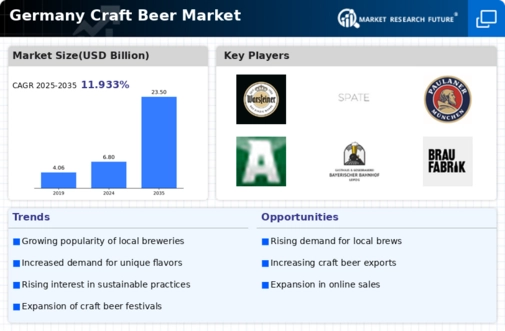The Germany Craft Beer Market has witnessed significant growth and diversification over the past few years, reflecting a dynamic shift in consumer preferences towards artisanal and locally produced beverages. With a strong tradition of brewing dating back centuries, Germany offers a rich tapestry of regional beer styles that cater to a growing audience seeking authenticity and unique flavor profiles. The craft beer sector has expanded beyond traditional options, as many smaller breweries and local startups have emerged, fostering a competitive landscape that is increasingly vibrant and innovative.
The market is characterized by a mix of long-established breweries and newer entrants, and trends such as the emphasis on sustainable brewing practices, local sourcing of ingredients, and creative experimentation with flavors and ingredients continue to shape the industry. Warsteiner Brauerei is one of the leading traditional breweries in Germany, renowned for its exceptional quality and consistent branding in the craft beer market. The company has built a solid reputation based on its commitment to traditional brewing techniques, which appeal to both local consumers and international markets.
Warsteiner offers a range of products, including its flagship pilsner, which embodies the classic characteristics reflective of German brewing heritage. Its strengths lie in the ability to combine traditional brewing practices with modern marketing strategies, which have ensured its robust presence across various distribution channels in Germany. Warsteiner's established brand recognition, extensive distribution networks, and partnerships with local retailers provide it with a competitive edge in the growing craft beer segment. Weihenstephan Brewery, rooted in history as one of the oldest breweries in the world, plays a significant role in the German craft beer market.
Located in Bavaria, it is well-known for its diverse range of beers, including lagers, wheat beers, and seasonal specialties, appealing broadly to craft beer enthusiasts. Weihenstephan Brewery focuses on maintaining high-quality standards through a sustainable approach in both brewing and sourcing its raw materials. The brewery has successfully embraced innovation while respecting its historical legacy, allowing it to have a significant market presence. Its strengths include a commitment to quality, an established reputation for excellence, and strong relationships with distributors and retailers within Germany.
Recent mergers and acquisitions have helped Weihenstephan Brewery expand its portfolio and reach, further solidifying its position in the competitive landscape of the German craft beer market.
















